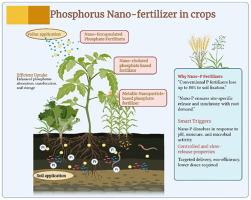Recent advances in phosphorus nano-fertilizers: Impacts on crop productivity and soil sustainability
IF 3.3
3区 农林科学
Q2 PLANT SCIENCES
引用次数: 0
Abstract
Phosphorus nano-fertilizers (P-nFs) can play a key role in the future of sustainable food production. Controlled release properties of these fertilizers reduce the leaching and eutrophication problems, reducing the fertilizer application rate, thereby ensuring nutrient use efficiency and reducing the input cost substantially. When traditional phosphorus fertilizers are applied to the soil, they get fixed in the soil, which results in limited availability to the plants. This leads to excessive fertilizer application. The aid of nanotechnology could overcome this problem. Nano phosphorus fertilizers are not fixed in the soil, and their release rate can be controlled, making them available for a longer duration in the growing season. This makes the nano phosphorus fertilizers environment-friendly and more efficient than traditional fertilizers. This paper provides a detailed review of the recent studies of nano phosphorus fertilizers in agriculture, and specific basic concerns and existing gaps in research need to be addressed and resolved. Despite these promising benefits, challenges such as synthesis scalability, environmental safety, and regulatory gaps continue to hinder large-scale adoption of P-nFs.

磷纳米肥料的最新进展:对作物生产力和土壤可持续性的影响
磷纳米肥料(P-nFs)在未来可持续粮食生产中发挥着关键作用。这些肥料的控释特性减少了淋溶和富营养化问题,降低了肥料的施用量,从而保证了养分的利用效率,大大降低了投入成本。当传统的磷肥施用于土壤时,它们会被固定在土壤中,这导致植物的可利用性有限。这导致过度施肥。纳米技术的帮助可以克服这个问题。纳米磷肥不固定在土壤中,其释放速度可以控制,使其在生长季节的持续时间更长。这使得纳米磷肥比传统肥料更加环保和高效。本文对近年来纳米磷肥在农业上的研究进展进行了综述,指出了纳米磷肥在农业上的应用需要解决的基本问题和存在的研究空白。尽管有这些有希望的好处,但诸如合成可扩展性、环境安全性和监管空白等挑战仍然阻碍了P-nFs的大规模采用。
本文章由计算机程序翻译,如有差异,请以英文原文为准。
求助全文
约1分钟内获得全文
求助全文
来源期刊
CiteScore
4.30
自引率
7.40%
发文量
130
审稿时长
38 days
期刊介绍:
Physiological and Molecular Plant Pathology provides an International forum for original research papers, reviews, and commentaries on all aspects of the molecular biology, biochemistry, physiology, histology and cytology, genetics and evolution of plant-microbe interactions.
Papers on all kinds of infective pathogen, including viruses, prokaryotes, fungi, and nematodes, as well as mutualistic organisms such as Rhizobium and mycorrhyzal fungi, are acceptable as long as they have a bearing on the interaction between pathogen and plant.

 求助内容:
求助内容: 应助结果提醒方式:
应助结果提醒方式:


